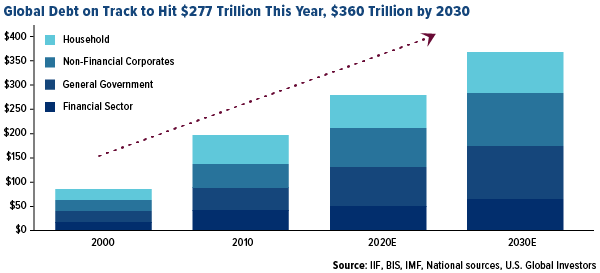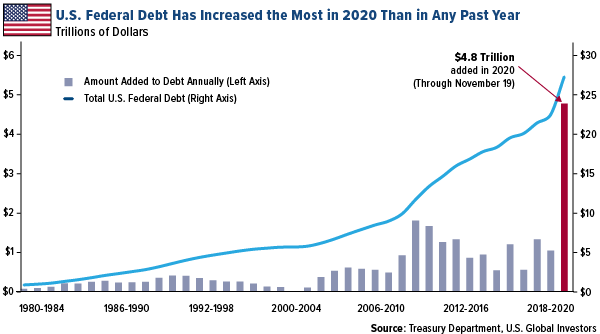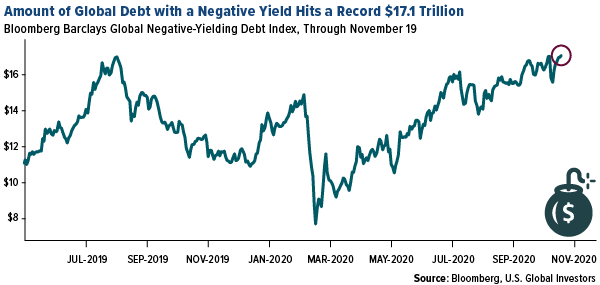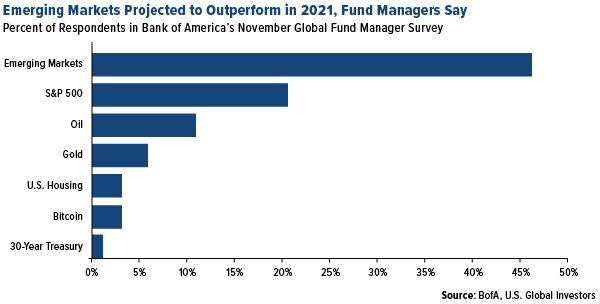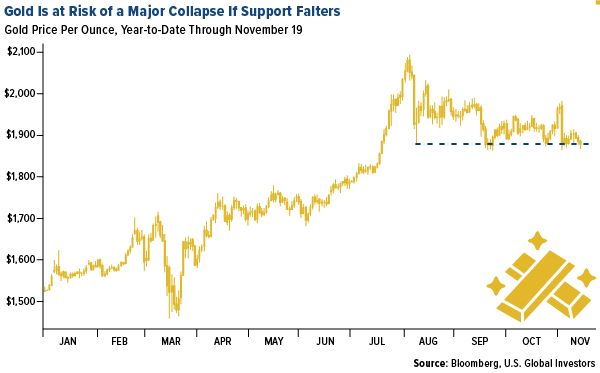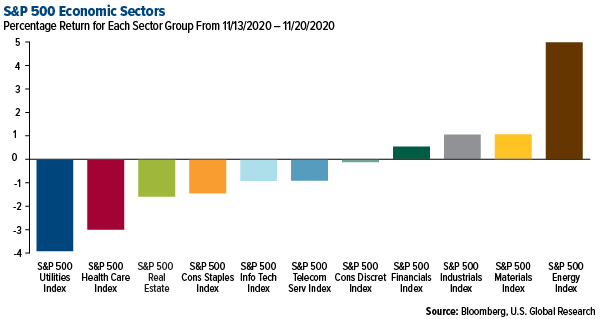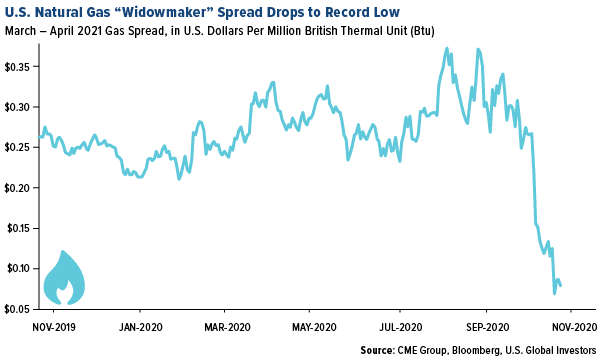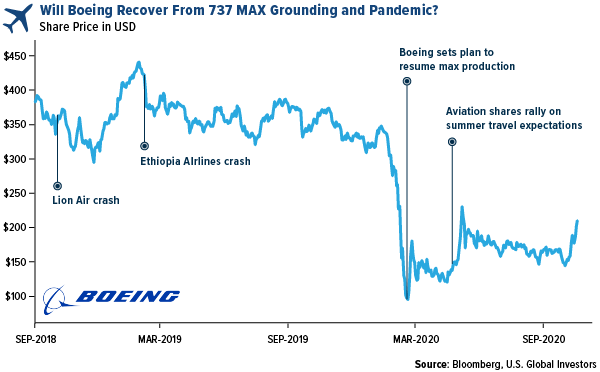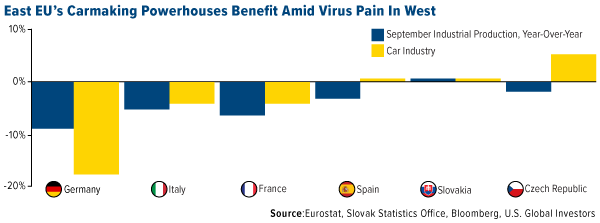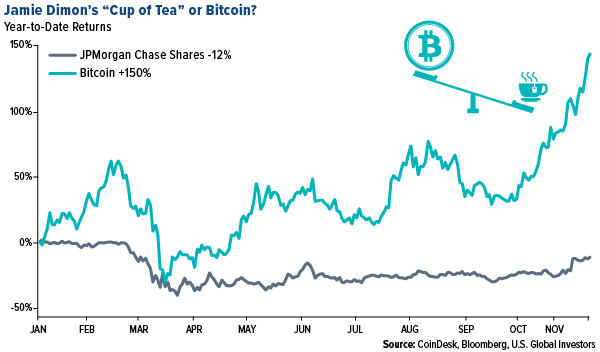
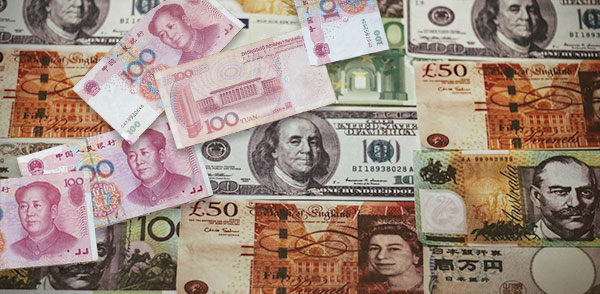
The World Has Racked Up $277 Trillion in Debt
How do you even begin to visualize $277 trillion? If we convert it into seconds, 277 trillion is the equivalent of 8.8 million years. I'm not sure what was happening that long ago, but I guarantee you it didn't involve people. It's been estimated that Jeff Bezos increases his net worth by about $321 million a day. At that rate, you'd have to work for close to 863,000 days, or 2,364 years, to reach $277 trillion.
By Frank Holmes
CEO and Chief Investment Officer
U.S. Global Investors

How do you even begin to visualize $277 trillion?
If we convert it into seconds, 277 trillion is the equivalent of 8.8 million years. I’m not sure what was happening that long ago, but I guarantee you it didn’t involve people.
It’s been estimated that Jeff Bezos increases his net worth by about $321 million a day. At that rate, you’d have to work for close to 863,000 days, or 2,364 years, to reach $277 trillion.
You get the point. It’s an unfathomable sum.
It’s also the total amount of debt the world is expected to hit by year-end. That’s according to the Institute of International Finance (IIF), whose members include some 400 banks and financial firms around the globe.
This year alone, as of the end of September, the world added $15 trillion to the debt pile, with government borrowing accounting for half of the increase, the IIF says. Debt in developed markets is set to hit 432% of gross domestic product (GDP). For emerging markets, it’s closer to 250%.
By 2030, the IIF estimates, we could be looking at $360 trillion in total debt.
So how did we get here, and what can investors do to protect their own wealth?
As you may expect, the economic fallout from the pandemic has dealt a huge blow to government coffers. So far in 2020, the U.S. has added more than $4.8 trillion to the federal debt, the most ever for a single year.
This has brought total federal debt up to a record $27 trillion, or 143% of U.S. GDP. Debt per U.S. taxpayer now comes in at a staggering $218,450.
We can’t blame everything on the pandemic. According to the IIF, the past four years have seen the largest debt buildup on record, with $52 trillion accumulated since 2016.
What this means is that, even during the pre-pandemic economic boom years, governments were not practicing sound fiscal management. Granted, governments weren’t the only contributors to the debt buildup, but they represent a huge part of it.
Knowing this, there’s no way we can reasonably expect them to get us out of this mess.
“There is significant uncertainty about how the global economy can deleverage in the future without significant adverse implications for economic activity,” IIF economists say.
Jared Dillian: Gold Is A Hedge Against Bad Government Decisions
This week, Bloomberg published an article by Jared Dillian, investment strategist at Mauldin Economics.
In the article, titled “Gold Is a Hedge Against Bad Government Decisions,” Dillian argues that investors mistakenly believe that gold is a hedge against inflation and stock market crashes.
Instead, he writes, gold “is a hedge on policymakers screwing up, and there has been a lot of screwing up in the last 20 years.”
Since the year 2000, U.S.-denominated gold has surged roughly 555% versus 146% for the S&P 500 Index. The reason for this, according to Dillian, is that “significantly looser financial conditions” have meant that there are “no constraints on monetary and fiscal policy.”
Indeed, the world is stuck in a low-rate environment. As of right now, no 10-year government bond in any major economy in Europe or North America yields more than 1%. Several countries—including France, Germany, Sweden, the Netherlands and Switzerland—issue debt with a negative yield. And that’s the nominal yield, before factoring in inflation.
Today, in fact, the amount of government debt around the world trading with a negative yield rose to $17.1 trillion, a troubling new record.
Currency devaluation is real, and it’s only likely to accelerate. If you’re seeking to protect your family’s wealth against the failures of governments and central banks, I don’t believe there’s a more prudent option than hard assets. That includes not just gold and precious metals but also real estate, housing and, if you can stand the volatility, cryptocurrencies such as Bitcoin and Ethereum.
Cryptos at a Nearly Three-Year High
Speaking of which, Bitcoin has been on a tear this year, having climbed almost 160%. Today, the world’s largest digital currency by market cap traded above $18,000, hitting its highest for the first time since December 2017. Ethereum, meanwhile, broke above $500, its highest level since June 2018.
The difference between then and now is that, whereas the 2017 Bitcoin rally was highly speculative and retail-driven, today’s surge appears to be propelled by smart money seeking to hedge against the things we just talked about.
That’s the assessment of ex-hedge fund manager Mike Novogratz. Speaking to CNBC this week, Novogratz said he believes Bitcoin has “hit escape velocity” as the cryptocurrency enjoys increasingly greater demand from institutional investors. He has an end-of-year price target of $20,000 and sees $60,000 by the end of 2021.
Emerging Markets to Outperform in 2021?
For what it’s worth, other fund managers aren’t in agreement with Novogratz. Less than 5% of those surveyed by Bank of America believe Bitcoin will outperform next year. Meanwhile, close to half of managers say they believe emerging markets are the place to be heading into 2021, ahead of the S&P 500, oil and gold.
Investors are betting that a vaccine against COVID-19 could benefit emerging economies the most. A weaker U.S. dollar may also make emerging markets more competitive. The U.S. Dollar Index is down more than 3% year-to-date.
Did You Miss the Mining Expo?
If you were one of the many people who attended last week’s Virtual Junior Mining Expo, thank you! The virtual event, co-hosted by StreetSmart Live!, was a huge success, bringing 10 of the most exciting junior metal producers to curious investors such as yourself.
For those of you who missed it or want to watch it again, a recording is now available. Just click here!
Gold Market
This week spot gold closed at $1,870.99, down $18.21 per ounce, or 0.96 percent. Gold stocks, as measured by the NYSE Arca Gold Miners Index, ended the week lower by 5.54 percent. The S&P/TSX Venture Index came in up 0.55 percent. The U.S. Trade-Weighted Dollar fell 0.43 percent.
| Date | Event | Survey | Actual | Prior |
|---|---|---|---|---|
| Nov-15 | China Retail Sales YoY | 5.0% | 4.3% | 3.3% |
| Nov-18 | Eurozone CPI Core YoY | 0.2% | 0.2% | 0.2% |
| Nov-18 | Housing Starts | 1460k | 1530k | 1459k |
| Nov-19 | Initial Jobless Claims | 700k | 742k | 711k |
| Nov-24 | Hong Kong Exports YoY | 6.0% | — | 9.1% |
| Nov-24 | Conf. Board Consumer Confidence | 98.0 | — | 100.9 |
| Nov-25 | Initial Jobless Claims | 733k | — | 742k |
| Nov-25 | GDP Annualized QoQ | 33.1% | — | 33.1% |
| Nov-25 | Durable Goods Orders | 0.9% | — | 1.9% |
| Nov-25 | New Home Sales | 975k | — | 959k |
Strengths
- The best performing precious metal for the week was platinum, up 6.26 percent, as hedge funds boost their net-long position to a two-year high on expectations platinum will find new demand in the green hydrogen space as the catalyst for electrolysis to liberate hydrogen. The World Platinum Investment Council projects a platinum deficit of 1.2 million ounces for 2020, the largest since records began. Pandemic-related mine closures by key producers is likely to keep the metal in deficit even as demand from autocatalysts, the biggest consumers of the metal, is forecast to drop by 16%. The metal could get a boost from the surge in green hydrogen interest. Platinum plays a key role in electrolysis and in the fuel cells used in hydrogen powered vehicles.
- Newmont is on the Dow Jones Sustainability World Index for the 13th year in a row, which represents the top 10% of the world’s largest 2,500 companies in the S&P Global Broad Market Index. Newmont was named the top global gold mining company for its leading environmental, social and governance (ESG) performance, reports Kitco News.
- Silver imports by China and India are expected to rebound over the next six months as de-stocking ends, according to Citigroup. Swiss gold exports to India rose almost fivefold in October as jewelers restocked ahead of Diwali, which is typically a strong time for purchases as gold gift giving is considered auspicious. BS sees palladium peaking at $2,600 an ounce in 2021 due to strong Chinese car sales and a COVID vaccine pushing the economic recovery and keeping the metal in deficit.
Weaknesses
- The worst performing precious metal for the week was silver, down 2.00 percent, yet hedge funds have now taken their net-long position to a 17-week high. Gold fell for a fourth day as the U.S. dollar strengthened on positive vaccine developments. Gold-backed ETFs sold off for a fifth straight session on Wednesday and have lost 52 tons of gold since Pfizer announced its vaccine breakthrough last week. This is sparking fears that investors are “giving up” on gold as it potentially heads back down to $1,700 an ounce. Demand for haven assets has fallen as the news of a COVID vaccine nearing gives investors hope for an economic recovery.
- Money managers are also turning bearish on the yellow metal. Bullish gold bets decreased by 10,994 net-long positions according to weekly CFTC data on futures and options. This is least bullish net-long position in more than 17 months, according to Bloomberg
- Macquarie said in notes this week that “gold prices have already peaked at their August high of $2,075 an ounce.” The banks said prices are likely to remain around current levels then progressively move lower over 2021 as the 10-year Treasury yield rises toward 2%. Bloomberg notes Macquarie has lowered its price outlooks for coming quarters after saying gold is at “the end of the cyclical bull market.”
Opportunities
- After saying last week it was discussing a “merger of equals,” Endeavour Mining announced it has agreed to buy Teranga Gold for a 5.1% premium. According to Bloomberg calculations Endeavour has valued Teranga at $1.86 billion and the combined company will produce 1.5 million ounces of gold across West Africa. The company now seeks to list on the London Stock Exchange.
- Brixton Metals announced high-grade gold, silver, and copper content in 17 samples collected at its recently acquired Trapper Target on its Thorn Project. A total of 11 companies were granted new gold mining concessions in Egypt, according to the Oil Ministry, including Centamin, Barrick Gold and B2Gold.
- Gold jumped on Friday morning after Treasury Secretary Steven Mnuchin said his agency and the Fed have enough firepower to continue supporting the U.S. economy. Citigroup remains bullish on gold even as a COVID vaccine nears completion. The bank says gold’s advance back above $2,000 an ounce in 2021 looks inevitable as the vaccine would only slow the bull cycle.
Threats
- Bullion is at risk of a “major collapse” if support continues to falter. The 100-day and 50-day moving average for gold just crossed, also called a death cross, and this is indicative of a “sharp drop” down in price, according to Gary Wagner, editor of the GoldForecast.com.
- Applications for U.S. state unemployment benefits rose unexpectedly for the first time in five weeks, suggesting the labor market recovery is slowly due to spiking coronavirus infections, reports Bloomberg. Claims totaled 742,000 in the week ended November 14, up 31,000 from the week prior. The U.S. now has over 11.8 million cases and reported 187,428 on Thursday November 19. The CDC has strongly advised against traveling for Thanksgiving and to only celebrate with those in your household.
- BlackRock CIO of Fixed Income Rick Rieder said on CNBC that bitcoin could take the place of gold to a large extent because crypto is “so much more functional than passing a bar of gold around.” Rieder added that he thinks crypto is here to stay due to central banks developing their own digital currencies and millennials’ “receptivity” to technology.
Index Summary
- The major market indices finished mixed this week. The Dow Jones Industrial Average lost 0.73%. The S&P 500 Stock Index fell 0.77%, while the Nasdaq Composite gained 0.22%. The Russell 2000 small capitalization index rose 2.37% this week.
- The Hang Seng Composite gained 1.32% this week; while Taiwan was up 3.34% and the KOSPI rose 2.39%.
- The 10-year Treasury bond yield fell 7 basis points to 0.825%.
Domestic Economy and Equities
Strengths
- Sales of existing homes in October soared well past expectations, rising 4.3% compared with September and 26.6% annually to a seasonally adjusted annualized rate of 6.85 million units, according to the National Association of Realtors. The annualized sales rate is the highest since February 2006.
- U.S. industrial production rose in October, as output continued its slow climb back from deep declines last spring due to pandemic-related shutdowns. The Federal Reserve on Tuesday said its index of industrial production—a measure of output at factories, mines and utilities—rose a seasonally adjusted 1.1% in October, following a revised 0.4% decline in September.
- Diamondback Energy was the best performing S&P 500 stock for the week, increasing 18.57 percent. Shares rallied after rumors of a potential takeover. Tesla rallied 21% this week on news it will join the S&P 500.
Weaknesses
- Applications for U.S. state unemployment benefits rose for the first time in five weeks and remained well above pre-virus levels, suggesting the labor-market recovery is slowing amid a surging pandemic and fresh business restrictions. Initial jobless claims in regular state programs totaled 742,000 in the week ended Nov. 14, up 31,000 from the prior week and compared with expectations for a decline.
- U.S. retail sales increased less than expected in October and could slow further, restrained by spiraling new Covid-19 infections. Retail sales rose 0.3% last month and data for September was revised down to show sales surging 1.6% instead of rising 1.9% as previously reported.
- Walgreens Boots Alliance was the worst performing S&P 500 stock for the week, falling 12.13 percent. The stock slid after Amazon announced two new pharmacy offerings, Amazon Pharmacy and an Amazon Prime prescription savings benefit.
Opportunities
- The second print of third-quarter GDP on Wednesday is likely to confirm a sharp rebound in economic activity from the previous quarter. The release will also provide details on corporate profits.
- According to Bloomberg strategists, the financial sector may have the greatest opportunity for upside surprise in 2021, given heavy discounts that imply credit quality fears and an embedded expectation for top-line weakness to remain.
- Roblox is going public. The gaming platform has skyrocketed in popularity since the start of the COVID-19 pandemic, with over 30 million active users per day.
Threats
- Next Tuesday’s consumer confidence survey is likely to be under pressure as COVD-related restrictions on activity mount and fiscal aid thins. Expectations are for a survey reading of 98, which would be down from the prior reading of 100.9.
- Jobless claims on Wednesday will test whether the spike during the November payroll survey week was a one-time blip or the start of a trend in which layoffs are rising amid accelerating COVID-19 cases.
- Barack Obama said social media firms should be treated as publishers. Current laws shield the likes of Facebook and Twitter from being liable for content that people post on their platforms. The current investigations underway in Congress could lead to the eventual reversal of those protections.
Energy and Natural Resources Market
Strengths
- The best performing commodity for the week was lumber, up 9.03 percent, on expected strong housing demand through the fall. Copper hit its highest since June 2018 on Monday after China reported better-than-expected industrial data. The top consuming nation has imported a record amount of the red metal, spurring a nearly 60% rally since March lows. Iron continues to rise, with futures nearing the highest this year in Singapore, on strong demand from Chinese steel mills and concerns over supply, reports Bloomberg. The LMEX Index of six base metals has surged more than 40% since the bottom in March.
- The World Platinum Investment Council projects a platinum deficit of 1.2 million ounces for 2020, the largest since records began. Pandemic-related mine closures by key producers is likely to keep the metal in deficit even as demand from autocatalysts, the biggest consumers of the metal, is forecast to drop by 16%. The metal could get a boost from the surge in green hydrogen interest. Platinum plays a key role in electrolysis and in fuel cells used in hydrogen powered vehicles.
- Amundi, Europe’s largest listed asset manager, announced it will partner with Cambridge and Oxford’s university endowments to start a low-carbon index tracking fund – the Amundi ESG Global Low Carbon Fund. The fund will aim to replicate the performance of the MSCI All Country World Index and will exclude fossil fuels and thermal coal. The fund will be open to other university endowments, charities and professional investors with a targeted size of $332 million in the first year.
Weaknesses
- The worst performing commodity for the week was natural gas, down 11.36 percent. Natural gas futures tumbled on Thursday as U.S. weather forecasts shifted warmer through early December. Bearish bets are growing after government data showed an unusually big gain in stockpiles for this time of year and a glut of fuel in underground storage. Bloomberg writes: “One sign of growing bearishness is the March-April gas spread, known as the widowmaker for its volatility. The premium for March prices versus April has narrowed to a record low for the 2021 contracts, suggesting that traders are increasingly skeptical about the prospect of tight supplies this winter.”
- Although average gasoline prices are at the lowest Thanksgiving level in four years of $2.17 per gallon, demand is down significantly due to the rising number of virus cases. According to fuel tracker GasBuddy, only 35% of Americans will travel by car for Thanksgiving, down from 65% a year ago. Gasoline demand has not increased since the end of summer and EIA shows supply is down 900,000 barrels a day from the same time last year. Bloomberg notes this is the equivalent of taking 1.5 million Ford F-150s off the road.
- UBS shifted its view on commodities from “most-preferred” to “neutral” due to recent rallies and near-term risks to demand due to new waves of COVID infections warranting profit-taking. The Bloomberg Commodity Spot Index is up 6% year-to-date and hit the highest since May 2018 on Wednesday. Bloomberg notes UBS’s cautious view contrasts with Goldman’s mostly positive outlook. UBS does still prefer oil and gold.
Opportunities
- BloombergNEF released its annual New Energy Outlook – a long-term analysis on the future of the energy economy. Key findings include global emissions peaked in 2019 and green power could see an influx of $11 trillion of investing in the coming decades. The impact of the pandemic will subtract 2.5 years of energy sector emissions between 2020 and 2050, due to lockdowns keeping people at home.
- Canadian lumber producer West Fraser Timber agreed to buy Norboard in an all-stock deal for $3.05 billion to expand into wood products, reports Bloomberg. Norboard is North America’s largest producer of oriented strand board, a plywood substitute used in residential construction. Canadian lumber companies have reported record earnings on the wave of construction during the pandemic.
- China’s State Power Investment Corp (SPIC) bought Mexico’s largest independent renewables company, Zuma Energia, for an undisclosed price. This is SPIC’s first investment in Mexico. Bloomberg notes this is a growing trend of Chinese energy companies buying Latin American assets. State Grid Corp of China announced earlier this month that it plans to buy a Chilean electricity network company for $3 billion.
Threats
- The Trump administration is hurrying to issue permits, finalize major environmental regulations and sell rights to drill for oil in Alaska ahead of the incoming Biden administration. All of these things could complicate Biden’s climate and conservation agenda and create more work for the new staff coming in. New official could unwind Trump rules, but that consumes time and resources, and Congress will likely remain under Republican control.
- Gold-backed ETFs sold off for a fifth straight session on Wednesday and have lost 52 tons of gold since Pfizer announced its vaccine breakthrough last week. This is sparking fears that investors are “giving up” on gold as it potentially heads back down to $1,700 an ounce. Demand for haven assets has fallen as the news of a COVID vaccine nearing gives investors hope for an economic recovery.
- The Federal Energy Regulatory Commission launched just six new investigations of wrongdoing in energy markets in fiscal year 2020 – a record low and a 50% drop from last year. This is prompting concerns that regulators have been soft on enforcement under President Trump, writes Bloomberg’s Naureen S. Malik. In 2020, the commissions probes resulted in $550,000 in penalties, compared with $94 million in penalties ordered in 2017. Perhaps there is simply less wrongdoing in recent years? Or there is less enforcement.
Airline Sector
Strengths
- The best performing airline for the week was Azul SA, up 21.07%.
- Airlines surged at the beginning of this week, just as they did last week, on more positive vaccine news. Pfizer announced on Wednesday that its coronavirus vaccine was 95% effective and had no serious side effects. Unicef held a call with 40 carriers to make plans for the global vaccine distribution by air and to identify what commercial tasks each part can perform.
- U.S. regulators ruled that the Boeing 737 MAX can return to the skies with an extensive package of fixes, after the 20-month grounding following two deadly crashes. There are 72 of the planes in the U.S., another 315 in the rest of the world and around 450 built jets Boeing has been unable to deliver, amounting to billions of dollars in inventory that can now be sold. The manufacturer is still suffering from the impact of the pandemic as carriers globally have cancelled and deferred orders for new aircraft.
Weaknesses
- The worst performing airline for the week was Hainan Meilan International Holdings, down 8.25%. The Center for Disease Control (CDC) issued a statement on Thursday strongly recommending against traveling for Thanksgiving next week. Virus cases continue to surge in the U.S. and heavy travel around the holiday could risk even more cases and super-spreader events. Airlines have seen a sudden uptick in cancellations.
- United Airlines said it foresees a fourth-quarter revenue decline of around 67% after seeing a deceleration in bookings and an increase in cancellations. United expects daily cash burn for the quarter of around $15 million, plus $10 million of average debt principal payments and severance payments per day, reports Seeking Alpha. As the virus continues to surge once again, carriers are becoming less optimistic about a travel boost around Thanksgiving and Christmas.
- According to data from aviation analytics company Cirium, 31% of the world’s passenger jet fleet was in storage as of November 11, or around 8,100 aircraft. The proportion is higher in Europe – 35% grounded – where many countries are struggling to contain a resurgent virus outbreak.
Opportunities
- British Airways and partner American Airlines will begin offering COVID tests to some flyers in the biggest push yet to restart trans-Atlantic travel, reports Bloomberg. Free tests will be offered ahead of American flights from Dallas and British Airways trips from New York and Los Angeles starting November 25. Passengers will take tests 72 hours prior to departure and on arrival at Heathrow airport. A kit will then be given for a third check three days later.
- Although international air travel remains weak, domestic travel is recovering as certain countries ease restrictions with the pandemic under control. All 10 of the world’s busiest domestic routes so far in November are in Asia. The busiest rout is between South Korea’s capital Seoul and the island Jeju – with 1.3 million seats scheduled for the month.
- Jefferies began coverage of Southwest Airlines with a “buy” rating. The firm says the carrier is its top pick in the airline sector due to its domestic advantages over peers and hopes for U.S. traffic to return to normal levels by 2022.
Threats
- Due to liquidity concerns, Gogo sold its flagship commercial airline division to Intelsat at a fire-sale price. Ophelia Research writes that the sale is “illogical” and “value destructive” given the steep discount given in the sale and the other headwinds the company will face. Gogo provides in-flight broadband connectivity and wireless entertainment services for airlines.
- Southwest Airlines sent another 403 workers warnings they could be laid off, just a week after warning for the first time that there could be furloughs, as the carrier seeks to cut costs by 10%. Bloomberg writes this is a threat that it will fail to get unions to agree to a one-year, 10% pay cut.
- Although Boeing’s 737 MAX aircraft is cleared to fly again, it still faces the challenge of passenger fear after two deadly crashes. Some carriers are even giving passengers the option of changing flights if they are scheduled to fly on the aircraft. Another challenge is the timeline of the jets return. United said it will take 1,000 hours of work on each aircraft to prepare it for flights after a long time in storage and the extensive changes required. American is the first carrier to add the jet to its schedule, while Southwest, the largest buyer, said it won’t use the plane until the second quarter of 2021. The aircraft is also awaiting approval internationally.
Emerging Markets
Strengths
- The best performing country in emerging Europe for the week was Poland, gaining 3.4 percent. The best performing country in Asia this week was Taiwan, gaining 3.3 percent.
- The Russian ruble was the best performing currency in emerging Europe this week, gaining 1.4 percent. The Malaysian ringgit was the best performing currency in Asia this week, gaining 73 basis points.
- Equites across emerging markets continued their gains from the prior week on growing optimism that the pandemic will end soon due to highly effective vaccines possibly becoming available to the public relatively soon. Some emerging counties like China and Russia have already been distributing emergency vaccinations to people under high risk of contracting the disease.
Weaknesses
- The worst relative performing country in emerging Europe for the week was Russia, gaining 85 basis points. The worst performing country in Asia this week was Pakistan, losing 94 basis points.
- The Hungarian forint the worst performing currency in emerging Europe this week, losing 37 basis points. The Pakistani rupee was the worst performing currency in Asia this week, losing 1.2 percent.
- China is seeing more credit defaults. On Monday, a top Chinse chipmaker and a major car manufacturer announced debt defaults, expending a list of distressed state-liked firms that were not able to make payments on its debt obligations.
Opportunities
- Charlie Robertson from Renaissance Capital believes that the virus will pass in 2021 and investors will reallocate money to emerging markets. Moreover, he says that Joe Biden’s victory will benefit emerging markets. In Europe he recommends central Europe, however, the risk of more sanctions against Turkey and Russia may increase under the new U.S. Administration. In Asia, investors could favor the East Asia’s giant and Vietnam in frontier markets.
- European ETFs have enjoyed their highest weekly net inflows since December 2019 aimed ongoing vaccine optimism. Emerging European equites have been lagging their global peers on the recovery path back to the pre-pandemic levels and have room to appreciate further.
- China’s high demand for luxury cars is supporting Eastern European economies. The Czech Republic and Slovakia make the most cars in the world per capita and these two countries are benefiting from high demand for expensive autos coming from Chinese consumers. Car manufacturers plan to further expand production in eastern Europe due to still relatively cheap labor and a skilled workforce.
Threats
- Poland and Hungary blocked the proposed eurozone budget plan for 2021-2027 which may lead to a delayed distribution of EU funds, which are much needed under pandemic restrictions. Moreover, both countries may face measures for vetoing the plan.
- President Donald Trump has signed an executive order banning Americans from investing in Chinese firms that are owned or controlled by the Chinese military, banning U.S. investors from owning or trading 31 firms identified by the U.S. Department of Defense as “Communist Chinese military companies”. U.S. investors who already own shares of the banned companies will have until November 2021 to divest.
- The U.S. Administration may announce more measures against China in the coming weeks. One of the measures discussed by Trump’s Administration includes delisting Chinse ADRs. Goldman Sachs said that targeting U.S. listed Chinese companies may likely lead to the delisting of 233 Chinse ADRs with a total market value exceeding $1 trillion, according to a publication from August 11, 2020 “Forced Chinese ADR de-listing will harm Americans the most.”
Blockchain and Digital Currencies
Strengths
- Of the cryptocurrencies tracked by CoinMarketCap, the best performing for the week ended November 20 was zLOT Finance, up over 2,013%.
- Early in the week the price of bitcoin traded above $17,000 for the first time since January 2019, according to the CoinDesk 20 Price Index. Then, on Wednesday, it crossed $18,000. This pushes the cryptocurrency’s total market capitalization to over $315 billion, writes CoinDesk. According to Ben Zhou, CEO and co-founder of Bybit, bitcoin’s “spectacular surge” in 2020 largely mirrors its 2017 trajectory, with the key difference being the “infusion of institutional money.”
- Bitcoin has one of its wealthiest backers yet, reports Bloomberg. Ricardo Salinas Pliego, Mexico’s third-richest person, said in a Twitter post this week that he’s invested a chunk of his liquid assets in the world’s biggest cryptocurrency, the article continues. “Many people ask me if I have bitcoins…YES. I have 10% of my liquid portfolio invest in it,” said Salinas.
Weaknesses
- Of the cryptocurrencies tracked by CoinMarketCap, the worst performing for the week ended November 20 was Pamp Network, down 97.26%.
- OKEx’s mining pool has gone from being one of the world’s largest, to not mining any new blocks in over two weeks, writes CoinDesk. The firm lost 99.5% of its hash power one month after it suspended withdrawals from trading accounts. The firm’s mining clients appear to have jumped ship after the company lost contact with an executive and was forced to suspend withdrawals –causing the OKEx to lose nearly all its hash power.
- JPMorgan Chase CEO Jamie Dimon still believes that blockchain will have a pivotal role in the future of finance, writes CoinDesk, but refuses to give ground on his opposition to bitcoin. During a NYT DealBook Conference this week, Dimon discussed his support for blockchain technology, but repeated his longstanding believe that governments will ultimately more heavily regulate bitcoin. Even so, Dimon acknowledged that “very smart people” are buying into cryptocurrency, the article continues. “Let them do that,” he said. “It’s just not my cup of tea.”
Opportunities
- Digital asset manager Galaxy Digital, founded by Mike Novogratz, announced Monday in a press release that it is to launch a bitcoin fund in Canada. The CI Galaxy Bitcoin Fund is a collaboration with CI Global Asset Management, reports CoinDesk, and has had a preliminary prospectus approved by securities regulators for an initial public offering.
- A Twitter poll posted by actress Maisie Williams, asking her followers whether or not she should invest in bitcoin, caught the attention of major investor Mike Novogratz – who told Williams not to hesitate buying the digital asset. “The network effect has taken over. I see tons of new buyers and there is very little supply,” Novogratz commented. “It’s an easier trade here (than) at 11K. So YES, buy it.”
- Is cryptocurrency going mainstream? That’s the question posed by one Bloomberg article this week. According to the writeup, despite a couple of big crashes that destroyed billions in value – bitcoin is back. There are a few reasons why cryptocurrencies are back on people’s radar: PayPal allowing customers to buy and sell bitcoin and other cryptos, tech companies holding portions of cash reserves in bitcoin and Fidelity’s announcement of the first bitcoin mutual fund.
Threats
- Stablecoin project Origin Dollar (OUSD) sustained a re-entrancy attack on Tuesday, writes CoinDesk, resulting in a loss of funds worth $7 million. This includes over $1 million deposited by Origin and its founders and employees. CoinGecko reports that the team disabled deposits and the price of the project’s native token is down 85 percent since the attack.
- This week the billionaire founder of Bridgewater Associates Ray Dalio said he might be missing something about bitcoin, as the cryptocurrency surpasses $17,000, reports Bloomberg. “It’s not very good as a store-hold of wealth because its volatility is great and has little correlation with the prices of what I need to buy,” Dalio said on Twitter. “I can’t imagine central banks, big institutional investors, businesses or multinational companies using it. If I’m wrong about these things I would love to be corrected.”
- Some billionaire investors find that bitcoin is somewhat of a distraction, writes CoinTelegraph, even as the cryptocurrency bull run continues to boost adoption. Masayoshi Son, a billionaire technology entrepreneur and CEO of Japanese conglomerate SoftBank says he just “doesn’t understand” bitcoin and found the investment to be “distracting his own focus on his own business.”
Leaders and Laggards
| Index | Close | Weekly Change($) |
Weekly Change(%) |
|---|---|---|---|
| 10-Yr Treasury Bond | 0.83 | -0.07 | -8.13% |
| Oil Futures | 42.15 | +2.02 | +5.03% |
| Hang Seng Composite Index | 4,175.01 | +54.55 | +1.32% |
| S&P Basic Materials | 437.84 | +4.61 | +1.06% |
| Korean KOSPI Index | 2,553.50 | +59.63 | +2.39% |
| S&P Energy | 267.24 | +12.69 | +4.99% |
| Nasdaq | 11,854.97 | +25.68 | +0.22% |
| DJIA | 29,263.48 | -216.33 | -0.73% |
| Russell 2000 | 1,785.34 | +41.30 | +2.37% |
| S&P 500 | 3,557.54 | -27.61 | -0.77% |
| Gold Futures | 1,876.60 | -16.40 | -0.87% |
| XAU | 137.20 | -6.18 | -4.31% |
| S&P/TSX VENTURE COMP IDX | 740.45 | +4.08 | +0.55% |
| S&P/TSX Global Gold Index | 323.97 | -21.74 | -6.29% |
| Natural Gas Futures | 2.65 | -0.34 | -11.42% |
| Index | Close | Monthly Change($) |
Monthly Change(%) |
|---|---|---|---|
| Korean KOSPI Index | 2,553.50 | +182.64 | +7.70% |
| 10-Yr Treasury Bond | 0.83 | +0.00 | +0.12% |
| Gold Futures | 1,876.60 | -60.30 | -3.11% |
| S&P Basic Materials | 437.84 | +26.60 | +6.47% |
| S&P 500 | 3,557.54 | +121.98 | +3.55% |
| DJIA | 29,263.48 | +1,052.66 | +3.73% |
| Nasdaq | 11,854.97 | +370.28 | +3.22% |
| Oil Futures | 42.15 | +2.12 | +5.30% |
| Hang Seng Composite Index | 4,175.01 | +273.80 | +7.02% |
| S&P/TSX Global Gold Index | 323.97 | -37.76 | -10.44% |
| XAU | 137.20 | -10.88 | -7.35% |
| Russell 2000 | 1,785.34 | +181.57 | +11.32% |
| S&P Energy | 267.24 | +45.23 | +20.37% |
| S&P/TSX VENTURE COMP IDX | 740.45 | +29.25 | +4.11% |
| Natural Gas Futures | 2.65 | -0.37 | -12.24% |
| Index | Close | Quarterly Change($) |
Quarterly Change(%) |
|---|---|---|---|
| XAU | 137.20 | -13.68 | -9.07% |
| S&P/TSX Global Gold Index | 323.97 | -60.51 | -15.74% |
| Gold Futures | 1,876.60 | -78.40 | -4.01% |
| DJIA | 29,263.48 | +1,523.75 | +5.49% |
| S&P 500 | 3,557.54 | +172.03 | +5.08% |
| Nasdaq | 11,854.97 | +590.02 | +5.24% |
| Korean KOSPI Index | 2,553.50 | +279.28 | +12.28% |
| Natural Gas Futures | 2.65 | +0.30 | +12.80% |
| S&P Basic Materials | 437.84 | +46.78 | +11.96% |
| Russell 2000 | 1,785.34 | +221.04 | +14.13% |
| Oil Futures | 42.15 | -0.43 | -1.01% |
| Hang Seng Composite Index | 4,175.01 | +365.51 | +9.59% |
| S&P/TSX VENTURE COMP IDX | 740.45 | +0.97 | +0.13% |
| S&P Energy | 267.24 | -3.91 | -1.44% |
| 10-Yr Treasury Bond | 0.83 | +0.17 | +26.53% |
U.S. Global Investors, Inc. is an investment adviser registered with the Securities and Exchange Commission ("SEC"). This does not mean that we are sponsored, recommended, or approved by the SEC, or that our abilities or qualifications in any respect have been passed upon by the SEC or any officer of the SEC.
This commentary should not be considered a solicitation or offering of any investment product.
Certain materials in this commentary may contain dated information. The information provided was current at the time of publication.
Some links above may be directed to third-party websites. U.S. Global Investors does not endorse all information supplied by these websites and is not responsible for their content.
Holdings may change daily. Holdings are reported as of the most recent quarter-end. The following securities mentioned in the article were held by one or more accounts managed by U.S. Global Investors as of (09/30/2020):
United Airlines Holdings Inc
American Airlines Group Inc
Southwest Airlines Co
Newmont Corp
Endeavour Mining Corp
Brixton Metals Corp
Centamin PLC
Barrick Gold Corp
B2Gold Corp
Tesla Inc
Amazon.com Inc
*The above-mentioned indices are not total returns. These returns reflect simple appreciation only and do not reflect dividend reinvestment. The Dow Jones Industrial Average is a price-weighted average of 30 blue chip stocks that are generally leaders in their industry. The S&P 500 Stock Index is a widely recognized capitalization-weighted index of 500 common stock prices in U.S. companies. The Nasdaq Composite Index is a capitalization-weighted index of all Nasdaq National Market and SmallCap stocks. The Russell 2000 Index® is a U.S. equity index measuring the performance of the 2,000 smallest companies in the Russell 3000®, a widely recognized small-cap index. The Hang Seng Composite Index is a market capitalization-weighted index that comprises the top 200 companies listed on Stock Exchange of Hong Kong, based on average market cap for the 12 months. The Taiwan Stock Exchange Index is a capitalization-weighted index of all listed common shares traded on the Taiwan Stock Exchange. The Korea Stock Price Index is a capitalization-weighted index of all common shares and preferred shares on the Korean Stock Exchanges. The Philadelphia Stock Exchange Gold and Silver Index (XAU) is a capitalization-weighted index that includes the leading companies involved in the mining of gold and silver. The U.S. Trade Weighted Dollar Index provides a general indication of the international value of the U.S. dollar. The S&P/TSX Canadian Gold Capped Sector Index is a modified capitalization-weighted index, whose equity weights are capped 25 percent and index constituents are derived from a subset stock pool of S&P/TSX Composite Index stocks. The S&P 500 Energy Index is a capitalization-weighted index that tracks the companies in the energy sector as a subset of the S&P 500. The S&P 500 Materials Index is a capitalization-weighted index that tracks the companies in the material sector as a subset of the S&P 500. The S&P 500 Financials Index is a capitalization-weighted index. The index was developed with a base level of 10 for the 1941-43 base period. The S&P 500 Industrials Index is a Materials Index is a capitalization-weighted index that tracks the companies in the industrial sector as a subset of the S&P 500. The S&P 500 Consumer Discretionary Index is a capitalization-weighted index that tracks the companies in the consumer discretionary sector as a subset of the S&P 500. The S&P 500 Information Technology Index is a capitalization-weighted index that tracks the companies in the information technology sector as a subset of the S&P 500. The S&P 500 Consumer Staples Index is a Materials Index is a capitalization-weighted index that tracks the companies in the consumer staples sector as a subset of the S&P 500. The S&P 500 Utilities Index is a capitalization-weighted index that tracks the companies in the utilities sector as a subset of the S&P 500. The S&P 500 Healthcare Index is a capitalization-weighted index that tracks the companies in the healthcare sector as a subset of the S&P 500. The S&P 500 Telecom Index is a Materials Index is a capitalization-weighted index that tracks the companies in the telecom sector as a subset of the S&P 500. The NYSE Arca Gold Miners Index is a modified market capitalization weighted index comprised of publicly traded companies involved primarily in the mining for gold and silver. The Consumer Price Index (CPI) is one of the most widely recognized price measures for tracking the price of a market basket of goods and services purchased by individuals. The weights of components are based on consumer spending patterns. The Purchasing Manager’s Index is an indicator of the economic health of the manufacturing sector. The PMI index is based on five major indicators: new orders, inventory levels, production, supplier deliveries and the employment environment. The S&P/TSX Venture Composite Index is a broad market indicator for the Canadian venture capital market. The index is market capitalization weighted and, at its inception, included 531 companies. A quarterly revision process is used to remove companies that comprise less than 0.05% of the weight of the index, and add companies whose weight, when included, will be greater than 0.05% of the index. Gross domestic product (GDP) is the monetary value of all the finished goods and services produced within a country’s borders in a specific time period, though GDP is usually calculated on an annual basis. It includes all of private and public consumption, government outlays, investments and exports less imports that occur within a defined territory.
Formerly known as Dow Jones-UBS Commodity Spot Index (DJUBSSP), the Bloomberg Commodity Spot Index measures the price movements of commodities included in the Bloomberg CI and select subindexes. The MSCI All Country World Index is designed to represent performance of the full opportunity set of large- and mid-cap stocks across 23 developed and 26 emerging markets. The London Metals Exchange Index (LMEX) is a weighted index of six, designated, primary metals which include: Primary Aluminum, Zinc, Nickel, Lead, Copper and Tin. The Dow Jones Sustainability World Index represents the top 10% of the largest 2,500 companies in the S&P Global BMI based on long-term economic, environmental and social criteria. Bloomberg Barclays Global Aggregate Negative Yielding Debt Index represents the negative yielding segment of the global investment grade debt from twenty-four local currency markets. This multi-currency benchmark includes treasury, government-related, corporate and securitized fixed-rate bonds from both developed and emerging markets issuers.































